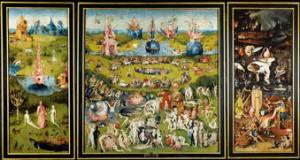The Garden of Earthly Delights is Bosch’s most ambitious and well-known piece. It depicts Bosch’s prime artistic state; no other paintings of his achieve such vivid imagery or such complexity of meaning. The dating of The Garden of Earthly Delights is uncertain, but is thought to have been created between 1503 and 1504, if not later. The Garden of Earthly Delights was first documented in Brussels, a year after Bosch’s death.
The Garden of Earthly Delights was created as a triptych, a work of art divided into three sections, or three carved panels that are connected and can be folded. The three panels are designed to reveal a sequence of events from left to right, in chronological order.
The first panel, located on the far left, is dedicated to Paradise, it portrays the Garden of Eden, from the Bible. It is the moment when God presents Eve to Adam.
The central panel presents an “expansive” garden landscape. It is a representation of the garden of life’s delights and pleasures. These pleasures are strongly represented by erotic representations of lust and arousal. The central panel is purposely placed between the panels of heaven and hell. Its setting does not equal the paradise depicted within the first panel, but it is also not based in a terrestrial realm. There are many symbolic characteristics of happiness, pleasure, and enjoyment within the middle region. A specific joyful example is portrayed through the couple enclosed in the glass ball. This could possibly allude to the Flemish saying, “happiness is like a glass, it soon breaks.”
The final panel, located on the far right is where the true message is brought to light. Hell is depicted. The idea is that the punishment for sinners is that their original vice will be their ending torture. The last panel’s scene is opposite to that of the first panel.
It seems to me that many aspects of The Garden of Earthly Delights are influenced by the Humanistic philosophy. As Eyecon Art states, “…the birth of a whole new way of thinking, one which centered on the world of mankind as much as a concern for the hereafter (which was the sole concern of medieval man). This new way of thinking is called humanism…” The Garden of Earthly Delights focuses on mankind and how the actions of mankind will affect their hereafter. Humanism believes that it is man’s privilege to choose his/her nature. This is also visibly depicted in The Garden of Earthly Delights.
I was first attracted to this piece while I was working on the written assignment for the Northern Renaissance. I find it beautiful and complex. I am in awe of the intricate detailing and appreciate that this piece has a story, in which it is intended to tell.
Works Cited:
